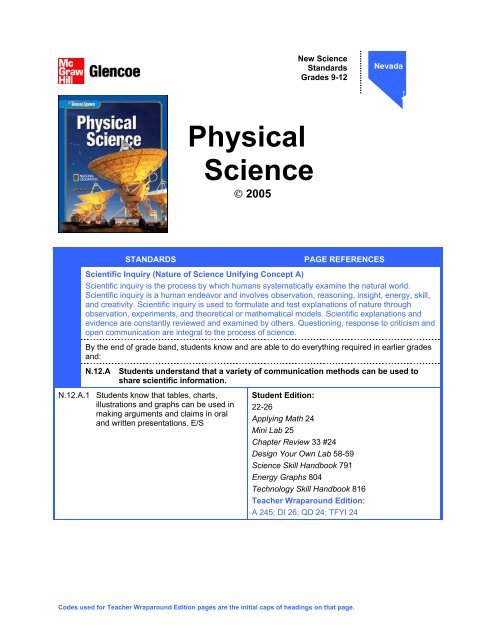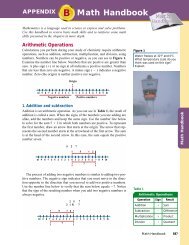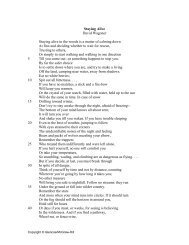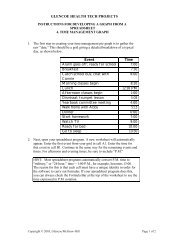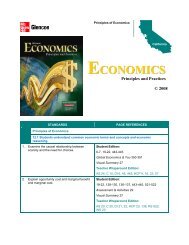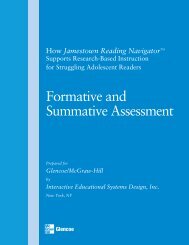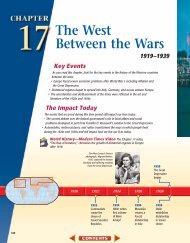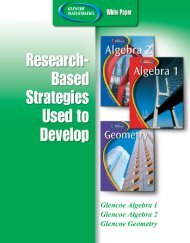Physical Science - Glencoe
Physical Science - Glencoe
Physical Science - Glencoe
Create successful ePaper yourself
Turn your PDF publications into a flip-book with our unique Google optimized e-Paper software.
STANDARDS PAGE REFERENCES<br />
Scientific Inquiry (Nature of <strong>Science</strong> Unifying Concept A)<br />
Scientific inquiry is the process by which humans systematically examine the natural world.<br />
Scientific inquiry is a human endeavor and involves observation, reasoning, insight, energy, skill,<br />
and creativity. Scientific inquiry is used to formulate and test explanations of nature through<br />
observation, experiments, and theoretical or mathematical models. Scientific explanations and<br />
evidence are constantly reviewed and examined by others. Questioning, response to criticism and<br />
open communication are integral to the process of science.<br />
By the end of grade band, students know and are able to do everything required in earlier grades<br />
and:<br />
N.12.A Students understand that a variety of communication methods can be used to<br />
share scientific information.<br />
N.12.A.1 Students know that tables, charts,<br />
illustrations and graphs can be used in<br />
making arguments and claims in oral<br />
and written presentations. E/S<br />
<strong>Physical</strong><br />
<strong>Science</strong><br />
© 2005<br />
New <strong>Science</strong><br />
Standards<br />
Grades 9-12<br />
Student Edition:<br />
22-26<br />
Applying Math 24<br />
Mini Lab 25<br />
Chapter Review 33 #24<br />
Design Your Own Lab 58-59<br />
<strong>Science</strong> Skill Handbook 791<br />
Energy Graphs 804<br />
Technology Skill Handbook 816<br />
Teacher Wraparound Edition:<br />
A 245; DI 26; QD 24; TFYI 24<br />
Codes used for Teacher Wraparound Edition pages are the initial caps of headings on that page.<br />
Nevada<br />
Misso Arizon
STANDARDS PAGE REFERENCES<br />
N.12.A.2 Students know that scientists maintain a<br />
permanent record of procedures, data,<br />
analyses, decisions, and understandings<br />
of scientific investigations. I/S<br />
N.12.A.3 Students know that repeated<br />
experimentation allows for<br />
statistical analysis and unbiased<br />
conclusions. E/S<br />
N.12.A.4 Students know how to safely conduct an<br />
original scientific investigation using the<br />
appropriate tools and technology. E/L<br />
N.12.A.5 Students know that models and<br />
modeling can be used to identify and<br />
predict cause-effect relationships. I/S<br />
Student Edition:<br />
6-10, 516-517, 788-796, 791-796<br />
Chapter Review 33 #19<br />
National Geographic 510<br />
Teacher Wraparound Edition:<br />
A 9; AIL 28; IL 12; QD 10; VL 12<br />
Student Edition:<br />
10, 793, 823<br />
Chapter Review 33 #22<br />
Teacher Wraparound Edition:<br />
CC 10; DI 10; FF 8,10<br />
Student Edition:<br />
797, 798-799<br />
Design Your Own Lab 28-29<br />
Chapter Review 33 #25<br />
Mini Lab 259<br />
Teacher Wraparound Edition:<br />
A 13, 276, 718; CD 8; DI 258; VL 12<br />
Student Edition:<br />
11, 509-511, 791<br />
<strong>Science</strong> Online 7<br />
Integrate Earth <strong>Science</strong> 11<br />
Integrate Physics 30<br />
National Geographic 510<br />
www.gpscience.com -> Student Edition -><br />
Brain Pop -> Atomic Model<br />
Teacher Wraparound Edition:<br />
A 11, 510; IP 30; VL 11<br />
New <strong>Science</strong> Standards 2 <strong>Physical</strong> <strong>Science</strong><br />
Grades 9-12 © 2005
STANDARDS PAGE REFERENCES<br />
<strong>Science</strong>, Technology, and Society (Nature of <strong>Science</strong> Unifying Concept B)<br />
Technology defines a society or era. It can shape the environment in which people live, and it has<br />
increasingly become a larger part of people’s lives. While many of technology’s effects on society<br />
are regarded as desirable, other effects are seen as less desirable. Instruction in this area should<br />
not be solely in science or technology courses, but should be shared by science, math,<br />
technology, social studies and language arts. The development and use of technology affects<br />
society and the environment in which we live, and at the same time society influences the<br />
development of technology and its impact on culture.<br />
By the end of grade band, students know and are able to do everything required in earlier grades<br />
and:<br />
N.12.B Students understand the impacts of science and technology in terms of costs and<br />
benefits to society.<br />
N.12.B.1 Students know that science, technology,<br />
and society influenced one another in<br />
both positive and negative ways. E/S<br />
N.12.B.2 Students know the influence of ethics on<br />
scientific enterprise. E/S<br />
N.12.B.3 Students know that scientific knowledge<br />
builds on previous information. E/S<br />
Student Edition:<br />
<strong>Science</strong> and Society 150, 280<br />
<strong>Science</strong> and History 248, 314<br />
Teacher Wraparound Edition:<br />
CB 150, 280, 314; D 280, 376; HS 248, 314;<br />
SJ 176<br />
Student Edition:<br />
797<br />
www.gpscience.com -> <strong>Science</strong> Home -> Find<br />
Your Book Here -> OH -> Biology -> Biology:<br />
Dynamics of Life -> Web Links -> Unit 1 -><br />
Chapter 2 -> Web -> National Academy Press<br />
Teacher Wraparound Edition:<br />
A 118; AIL 28<br />
Student Edition:<br />
76, 509-511, 516-517<br />
<strong>Science</strong> and History 92, 118<br />
<strong>Science</strong> and History 118<br />
National Geographic 510<br />
www.gpscience.com -> Student -> Brain Pop -><br />
Atomic Model<br />
Teacher Wraparound Edition:<br />
A 45 Pangaea; CB 92, 376; CC 233; DI 511;<br />
FF 76; HS 92, 118; I 92; VL 509<br />
New <strong>Science</strong> Standards 3 <strong>Physical</strong> <strong>Science</strong><br />
Grades 9-12 © 2005
STANDARDS PAGE REFERENCES<br />
Matter (<strong>Physical</strong> <strong>Science</strong> Unifying Concept A)<br />
Matter has various states with unique properties that can be used as a basis for organization. The<br />
relationship between the properties of matter and its structure is an essential component of study<br />
in the physical sciences. The understanding of matter and its properties leads to practical<br />
applications, such as, the capability to liberate elements from ore, create new drugs, manipulate<br />
the structure of genes and synthesize polymers.<br />
By the end of grade band, students know and are able to do everything required in earlier grades<br />
and:<br />
P.12.A Students understand that atomic structure explains the properties and behavior of<br />
matter.<br />
P.12.A.1 Students know that different molecular<br />
arrangements and motions account for<br />
the different physical properties of solids,<br />
liquids, and gases. E/S<br />
P.12.A.2 Students know that elements in the<br />
periodic table are arranged into groups<br />
and periods by repeating patterns and<br />
relationships. E/S<br />
P.12.A.3 Students know identifiable properties<br />
can be used to separate mixtures. E/S<br />
Student Edition:<br />
477-478<br />
<strong>Science</strong> Online 479<br />
Integrating History 482<br />
Section Review 483 #2-#4<br />
Chapter Review 500-501 #12, #16<br />
Standard Test Practice 503 #6<br />
Teacher Wraparound Edition:<br />
A 483; CC 479; DI 483; IL 479; UA 477<br />
Student Edition:<br />
505, 512-515, 516-524, 570-577, 578-591<br />
Unit Project 447 “Technology”<br />
Mini Lab 517<br />
Lab 525<br />
Lab 526-527<br />
Teacher Wraparound Edition:<br />
504 F; A 524, 525, 527; AIL 526; AT 529; CC 518;<br />
DI 524; TFYI 610<br />
Student Edition:<br />
452-456<br />
Mini Lab 453<br />
Integrate Earth <strong>Science</strong> 456<br />
Lab 457<br />
Teacher Wraparound Edition:<br />
A 456; CC 454; D 454; DI 455, 456; IES 456; LD<br />
460; QD 455; TFYI 453; VL 454<br />
New <strong>Science</strong> Standards 4 <strong>Physical</strong> <strong>Science</strong><br />
Grades 9-12 © 2005
STANDARDS PAGE REFERENCES<br />
P.12.A.4 Students know atoms bond with one<br />
another by transferring or sharing<br />
electrons. E/S<br />
P.12.A.5 Students know that chemical reactions<br />
can take place at different rates,<br />
depending on a variety of factors (i.e.,<br />
temperature, concentration, surface<br />
area, and agitation). E/S<br />
P.12.A.6 Students know that chemical reactions<br />
either release or absorb energy. E/S<br />
P.12.A.7 Students know that in chemical<br />
reactions, elements combine in<br />
predictable ratios, and the numbers of<br />
atoms of each element do not change.<br />
I/S<br />
P.12.A.8 Students know that most elements have<br />
two or more isotopes, some of which<br />
have practical application. I/S<br />
P.12.A.9 Students know that the number of<br />
electrons in an atom determines<br />
whether the atom is electrically neutral or<br />
an ion. I/S<br />
Student Edition:<br />
604-606, 608-614<br />
Mini Lab 612<br />
National Geographic 613<br />
Teacher Wraparound Edition:<br />
600 E; A 606, 611, 614; D 610; DI 612, 613;<br />
TFYI 610; UA 604<br />
Student Edition:<br />
646-650, 668-670<br />
Lab 651<br />
Mini Lab 668<br />
Applying Math 669<br />
Teacher Wraparound Edition:<br />
A 655, 670; D 668; DI 670; FF 669; IL 673;<br />
TFYI 673<br />
Student Edition:<br />
461-463, 646-650<br />
Launch Lab 449<br />
Lab 466-467<br />
Teacher Wraparound Edition:<br />
630 F; A 649, 650; AIL 466; LD 648; TFYI 649<br />
Student Edition:<br />
461-463, 465<br />
Mini Lab 460<br />
Applying Math 463<br />
Lab 467<br />
Teacher Wraparound Edition:<br />
CD 463; DI 465; IL 462; IM 469; QD 463; VL 461<br />
Student Edition:<br />
512-515<br />
Applying <strong>Science</strong> 514<br />
Integrate Life <strong>Science</strong> 514<br />
Teacher Wraparound Edition:<br />
504 E; A 515; DI 514, 515; ILS 514; TFYI 513;<br />
VL 514<br />
Student Edition:<br />
507, 608-610, 615-616<br />
Applying Math 617<br />
Teacher Wraparound Edition:<br />
A 515, 610; D 513, 610; IM 616; QD 616; TFYI 610<br />
New <strong>Science</strong> Standards 5 <strong>Physical</strong> <strong>Science</strong><br />
Grades 9-12 © 2005
STANDARDS PAGE REFERENCES<br />
Forces and Motion (<strong>Physical</strong> <strong>Science</strong> Unifying Concept B)<br />
The laws of motion are used to describe the effects of forces on the movement of objects. Force<br />
may be treated as the originator of motion.<br />
By the end of grade band, students know and are able to do everything required in earlier grades<br />
and:<br />
P.12.B Students understand the interactions between force and motion.<br />
P.12.B.1 Students know that magnetic forces and<br />
electric forces can be thought of as<br />
different aspects of a single<br />
electromagnetic force. I/S<br />
P.12.B.2 Students know that the strength of the<br />
electric force between two objects<br />
increases with charge, and decreases<br />
with distance. I/S<br />
P.12.B.3 Students know that the strength of the<br />
gravitational force between two objects<br />
increases with mass, and decreases<br />
rapidly with distance. I/S<br />
P.12.B.4 Students know that laws of motion can<br />
be used to determine the effects of<br />
forces on the motion of objects. E/S<br />
Student Edition:<br />
223-230, 231-237<br />
Launch Lab 223<br />
<strong>Science</strong> Online 223<br />
Section Review 237 #1-#5<br />
Lab 245<br />
Design Your Own Lab 246-247<br />
Teacher Wraparound Edition:<br />
AIL 246; CB 248; D 248; HS 248<br />
Student Edition:<br />
192-194, 196<br />
<strong>Science</strong> Online 196<br />
<strong>Science</strong> Journal 196<br />
National Geographic 197<br />
www.gpscience.com -> Student -> Brain Pop -><br />
Magnetism<br />
Teacher Wraparound Edition:<br />
A 193, 197; IM 196; UA 193<br />
Student Edition:<br />
75-79<br />
<strong>Science</strong> Online 76<br />
Integrate Earth <strong>Science</strong> 79<br />
Teacher Wraparound Edition:<br />
A 78, 79; CC 79; D 78; DI 77; FF 76; QD 76, 77,<br />
78; TFYI 78<br />
Student Edition:<br />
54-56, 68-70<br />
Lab 57<br />
Lab Design Your Own 58-59<br />
www.gpscience.com -> Teacher -> Webquest<br />
Projects -> Unit 1 Energy and Motion<br />
Teacher Wraparound Edition:<br />
66 E, F; AIL 58; TC 66<br />
New <strong>Science</strong> Standards 6 <strong>Physical</strong> <strong>Science</strong><br />
Grades 9-12 © 2005
STANDARDS PAGE REFERENCES<br />
P.12.B.5 Students know that an object's motion<br />
can be interpreted from graphical<br />
representations. E/S<br />
Student Edition:<br />
41-43, 50<br />
National Geographic 49<br />
Chapter Review 62-63 #17, #28<br />
Teacher Wraparound Edition:<br />
36 F; A 46; DI 49, 51; LD 50; VA 49<br />
Energy (<strong>Physical</strong> <strong>Science</strong> Unifying Concept C)<br />
The total energy of the universe is constant. All events involve the transfer of energy in one form<br />
or another. In all energy transfers, the overall effect is that the energy is spread out uniformly.<br />
By the end of grade band, students know and are able to do everything required in earlier grades<br />
and:<br />
P.12.C Students understand that there are interactions between matter and energy.<br />
E.12.A.1 Students know that the sun is the major<br />
source of Earth’s energy, and provides<br />
the energy driving Earth’s weather and<br />
climate. E/S<br />
P.12.C.1 Students know that waves (i.e., sound,<br />
seismic, electromagnetic) have energy<br />
that can be transferred when the waves<br />
interact with matter. E/S<br />
Student Edition:<br />
167<br />
National Geographic 166<br />
Mini Lab 168<br />
Lab 171<br />
<strong>Science</strong> Stats 182<br />
Teacher Wraparound Edition:<br />
CB 182; CC 167; D 167; DI 170; IM 167; LD 165;<br />
USW 167<br />
Student Edition:<br />
290-295, 296-301, 303-311, 322-324<br />
Launch Lab 289<br />
Foldables 289<br />
National Geographic 294<br />
<strong>Science</strong> Online 295<br />
Mini Lab 297<br />
Integrate Social Studies 299<br />
Lab 302<br />
<strong>Science</strong> and History 314<br />
www.gpscience.com -> Student -> Brain Pop -><br />
Waves<br />
Teacher Wraparound Edition:<br />
288 E, F; A 294, 295; DI 294, 295, 300; IM 299;<br />
TFYI 294; VL 300<br />
New <strong>Science</strong> Standards 7 <strong>Physical</strong> <strong>Science</strong><br />
Grades 9-12 © 2005
STANDARDS PAGE REFERENCES<br />
P.12.C.2 Students know that nuclear reactions<br />
convert a relatively small amount of<br />
material into a large amount of energy.<br />
I/S<br />
P.12.C.3 Students know characteristics,<br />
applications and impact of radioactivity.<br />
E/S<br />
P.12.C.4 Students know that energy forms can be<br />
converted. E/S<br />
P.12.C.5 Students know that temperature of a<br />
substance is directly related to the<br />
average kinetic energy of its constituent<br />
particles. I/S<br />
P.12.C.6 Students know that electricity is<br />
transferred from generating sources for<br />
consumption and practical uses. I/S<br />
Student Edition:<br />
113, 264-270, 551-553<br />
<strong>Science</strong> Online 113<br />
Teacher Wraparound Edition:<br />
A 270; CC 265; D 265; DI 265, 270; FF 270;<br />
QD 265; TFYI 113, 265; UA 266, VL 265, 266<br />
Student Edition:<br />
268-270, 361-362, 537-540<br />
Integrate Social Studies 267<br />
<strong>Science</strong> Online 268<br />
<strong>Science</strong> and Society 280<br />
Teacher Wraparound Edition:<br />
A 268; AS 269; CC 265; IM 267; ISS 266; TFYI 268<br />
Student Edition:<br />
102-105, 107-115<br />
Launch Lab 99<br />
Lab 106<br />
National Geographic 112<br />
Mini Lab 112<br />
Design Your Own Lab 116-117<br />
Extra Try At Home Labs 801 “Energy Conversions”<br />
Teacher Wraparound Edition:<br />
A 115; AP 98; CC 102; CD 104; DI 105; FF 101<br />
Student Edition:<br />
158-163<br />
Launch Lab 157<br />
<strong>Science</strong> Online 160<br />
Applying Math 162<br />
Integrate Earth <strong>Science</strong> 162<br />
Teacher Wraparound Edition:<br />
156 E, F; A 163; CC 160; D 161; DI 161, 163;<br />
QD 161; VL 159<br />
Student Edition:<br />
238-244, 256-257, 260-263, 267, 273-275<br />
Integrate Careers 240<br />
National Geographic 241<br />
<strong>Science</strong> Online 242<br />
Lab 245<br />
Teacher Wraparound Edition:<br />
A 241, 243; TFYI 243, 273; VL 240<br />
New <strong>Science</strong> Standards 8 <strong>Physical</strong> <strong>Science</strong><br />
Grades 9-12 © 2005


